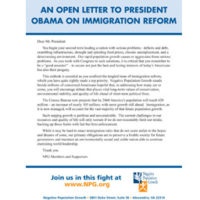Little Known Presidential Population Leadership
- Otis L. Graham, Jr
- January 19, 2013
- Forum Papers
- Forum Paper
- 0 Comments
The report offered the U.S. government’s best projections on global population, environmental and natural resource trends worldwide as of 2000, an immense effort of data gathering and extrapolation leaving no time, the authors decided, for policy recommendations which in any event would rest in the hands of the world’s independent governments. “Action” was urgently needed to preserve “the carrying capacity of the earth.” But no reader could miss the point that population – the first topic addressed – was the basic driver of the shortages and “global problems of alarming proportions” ahead.
* * *
We have toured a little known part of a larger story, which starts in mid-century with an environmentalist literature warning of overpopulation, producing what some would call a “Malthusian” shelf of books by authors such as Walter Prescott Webb, Osborn, Vojt, Garrett Hardin, Paul Ehrlich, The Club of Rome, and Jared Diamond, with a cascade of essays and articles and the discourse this generated. In the years 1958-1981 six presidential task forces/committees augmented this “overpopulation” literature by launching inquiries into the national security and natural resource dimensions and hazards of global and American demographic trends. The public audience for these presidential studies may have been small, but they were America’s political elites speaking to each other. The other side of the story was the fierce opposition to this “too many people” school. A critique surged through the 80s and 90s in the writings of some demographers, journalists, the uncategorizable Julian Simon, and journalists such as Ben Wattenberg.
* * *
We now return to our main theme, the presidential tradition of population studies. Some time in the early months of his presidency Bill Clinton learned that the 1992 Rio Conference obliged all signatories to report by 1997 on progress made in having sustainable development strategies in place by 2002.
It was either abide by the international accord struck in Rio or make a fuss, so President Clinton signed an Executive Order in June, 1993 establishing the President’s Council on Sustainable Development, a collection of some 25 business executives, government officials and community leaders whose assignment was to “advise the president on sustainable development.” This was less than the Earth Summit dreamers had in mind, but it was taken to be compliance.
* * *
Graham was Professor Emeritus of history at the University of California, Santa Barbara. He was the author or editor of more than fifteen books, including “Debating American Immigration, 1882-Present” (with Roger Daniels) and “Environment Politics and Policy, 1960s to 1990s”.

